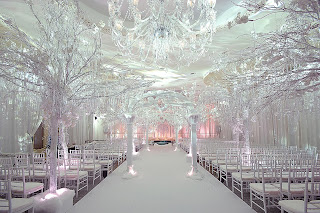For low centerpieces, I always like using a profusion of flowers. Use flowers that work together in the same color family, all purples or all reds for example, as opposed to too many colors in one arrangement, which can be distracting and less dramatic.
The benefit of a low centerpiece is that it enables guests to see each other across the table and allows an intimate experience. The benefit of a high centerpiece is that it serves as additional room decor and provides high drama.
Here are some tips for creating your own centerpieces:
- Think beyond flowers. In the picture above, using a tall black rod as a candleholder made the illusion that the candle was floating in the room. If you pair this with a beautiful low centerpiece, it brings a balance to the table.
- Flowers can have opposing fragrances. Be careful that the flowers you use don’t have a scent that could conflict with the food. Some examples of strong fragrant flowers are: gardenias, tuber roses, Casablanca lilies, and paper whites (narcissus). But just because you can’t use them at the table doesn’t mean you can’t use them in arrangements around the rest of the room. Certain clients request their favorite fragrances, so it’s always something we need to balance and pay attention to.
- I suggest using some low and some high centerpieces--it gives the room more of a flow across the space and it can be more cost-effective (lowers centerpieces are less expensive). The correct height of an average low centerpiece is when it’s low enough that you can see the person sitting across from you at the table. For an average high centerpiece, there are no rules (sky’s the limit).












